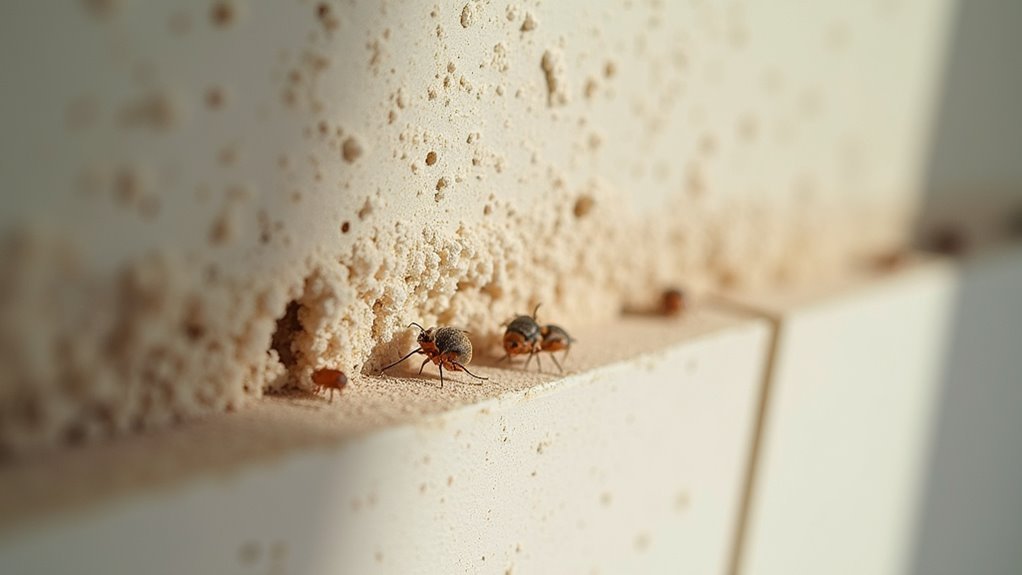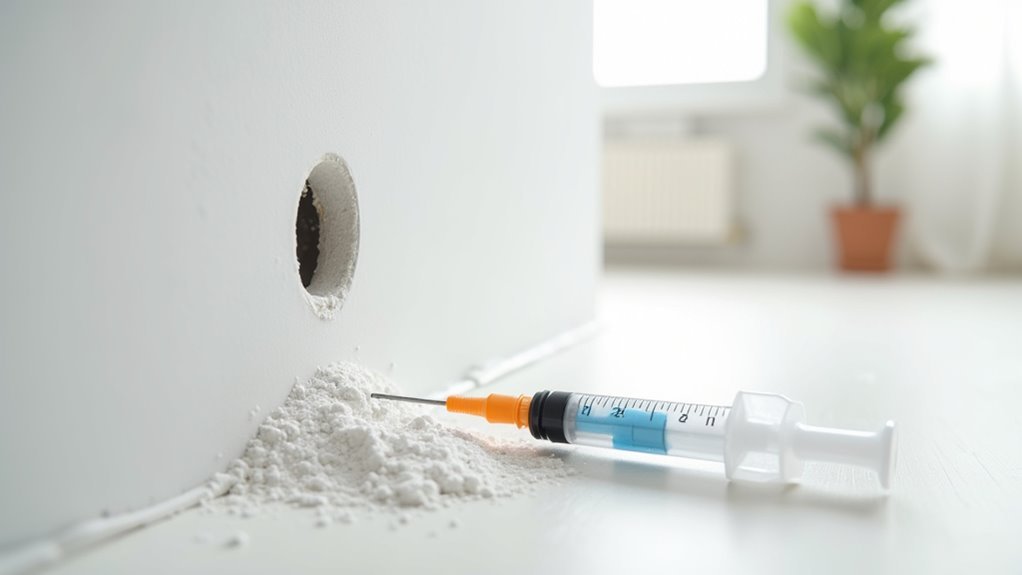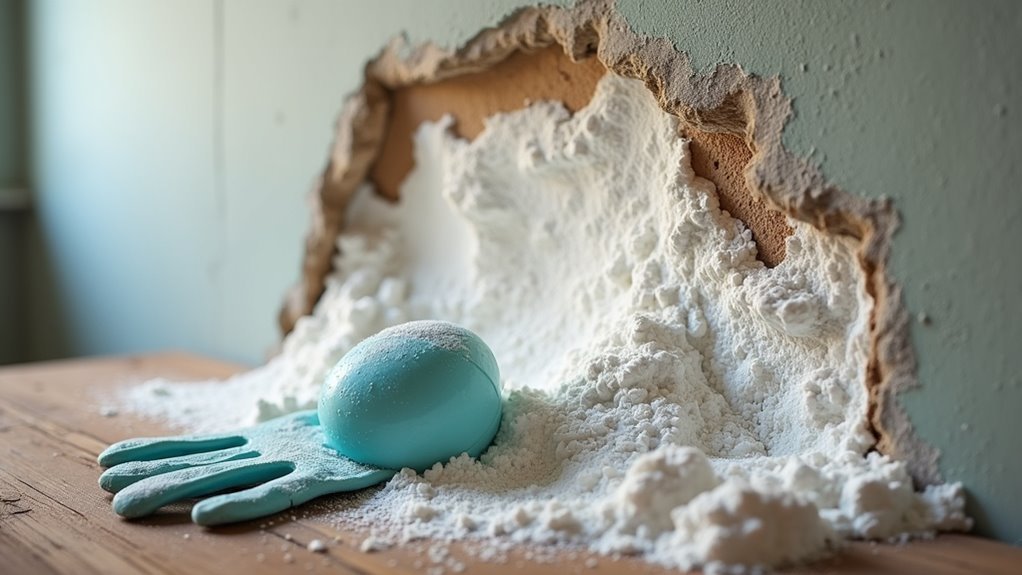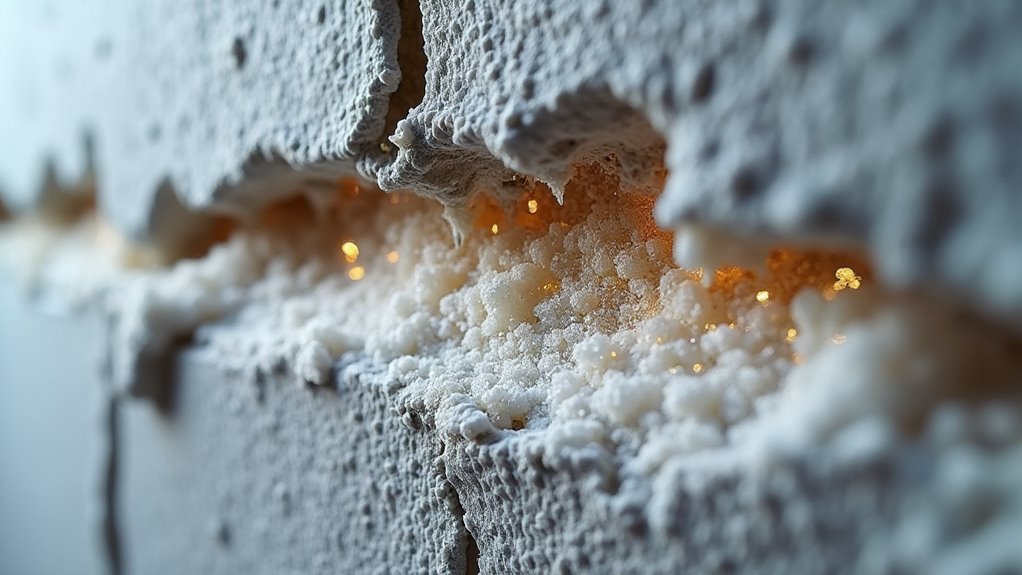When you apply boric acid inside walls, it creates a long-lasting pesticide barrier that kills cockroaches, termites, and other pests through dehydration and metabolic disruption. The powder remains effective for weeks to months in these dry environments, contaminating insects as they travel through wall cavities and spread the toxicant throughout their colonies. You’ll notice decreased pest activity and dead insects as signs it’s working. Understanding proper application methods and safety considerations will maximize your pest control success.
How Boric Acid Works as a Pesticide in Enclosed Spaces

When you apply boric acid inside wall cavities, it acts as a highly effective pesticide through a deceptively simple mechanism. The fine powder attracts insects with its texture, and they inadvertently ingest it while grooming after contact.
Once consumed, boric acid disrupts their metabolism and nervous system, causing dehydration and death.
Boric acid fatally disrupts insect metabolism and nervous systems, leading to dehydration and eliminating pests from within.
What makes this pest management approach particularly powerful is its spreading effect throughout colonies. Contaminated insects return to their nests, transferring the toxicant to others and eliminating infestations at their source.
The powder remains potent for extended periods within wall voids, providing long-term protection without losing effectiveness when it dries out.
Among control methods, boric acid’s low toxicity to humans and pets makes it ideal for interior applications when properly applied.
Target Pests That Live Inside Wall Cavities
Several common household pests make their homes within wall cavities, creating hidden infestations that can persist for months without detection. These wall-dwelling insects find perfect conditions for breeding and hiding from traditional pest control methods.
| Pest | Primary Damage | Boric Acid Effectiveness |
|---|---|---|
| Termites | Structural wood damage | High – disrupts metabolism |
| Cockroaches | Contamination, disease spread | Excellent – stomach poison effect |
| Silverfish | Paper, fabric destruction | Very effective – causes dehydration |
| Carpenter ants | Wood tunneling | Good – transferred through colony |
| Powderpost beetles | Fine wood powder damage | Moderate – penetrates hiding spots |
You’ll find boric acid powder particularly effective against these wall void inhabitants because it reaches areas where conventional sprays can’t penetrate. The fine particles settle into cracks and crevices where each pest species typically nests.
Application Methods for Wall Void Treatment

You’ll need to master two primary application methods when treating wall voids with boric acid.
First, you can dust wall cavities directly using a bulb duster to distribute a fine layer of powder throughout the void space.
Alternatively, you can inject boric acid through small entry points like cracks, gaps, or drilled holes to reach areas that aren’t easily accessible.
Dusting Wall Cavities
Precision becomes paramount when dusting wall cavities with boric acid, as this method requires you to apply a fine layer of powder directly into wall voids where pests hide and travel.
Using a bulb duster, you’ll effectively coat surfaces within cavities, allowing cockroaches and termites to walk through the dust. The powder adheres to their bodies and gets ingested during grooming, providing excellent control.
Essential Application Steps:
- Target high-traffic areas – Focus on spaces where you’ve spotted pest droppings or sightings, ensuring boric acid penetrates deep into nesting areas.
- Use tamper-resistant stations – Apply powder in sealed areas to minimize accidental exposure to children and pets.
- Monitor and reapply regularly – Check effectiveness frequently, especially after moisture exposure, since wet boric acid loses potency.
Injection Through Entry Points
When treating wall voids through injection, you’ll achieve maximum pest control by targeting entry points where insects frequently access hidden spaces.
You can apply boric acid using a dust applicator or bulb duster through small holes, reaching areas where cockroaches and termites nest or travel. This injection method effectively addresses hidden insect infestations that traditional surface treatments can’t reach.
Create a fine layer of boric acid dust within the wall cavities, ensuring it adheres to surfaces where pests will contact the toxic substance over time.
After application, you must seal all injection points to prevent pest escape and maintain treatment effectiveness.
Monitor treated areas regularly, as you may need additional boric acid applications depending on ongoing pest activity and infestation severity levels.
Why Wall Placement Increases Effectiveness Against Roaches
Strategic placement of boric acid inside walls dramatically amplifies its roach-killing power by targeting these pests where they’re most vulnerable.
When you apply boric acid in wall cavities, you’re attacking roach infestations at their source – the dark, humid spaces where they nest and breed.
Here’s why wall placement maximizes effectiveness:
- Creates a poison relay system – Roaches carry boric acid back to their nests, eliminating entire colonies through secondary exposure.
- Provides undisturbed contact time – Wall voids offer sheltered environments where roaches encounter the treatment without human interference.
- Ensures long-term residual activity – Dry wall spaces preserve boric acid’s potency, delivering continuous pest control even in low-traffic areas.
This strategic approach transforms your walls into 24/7 roach elimination zones.
Safety Considerations When Using Boric Acid in Walls

While boric acid’s wall placement strategy delivers powerful roach control, you must prioritize safety during application and storage.
When applying boric acid inside walls, choose locations completely inaccessible to children and pets to prevent accidental exposure or ingestion. Always wear protective gloves and a mask to avoid skin irritation and respiratory discomfort from dust inhalation.
Ensure proper ventilation throughout the application process, as inhaling significant amounts of boric acid dust can cause respiratory issues. Avoid placing the powder in damp wall areas where moisture reduces effectiveness and promotes mold growth.
Store unused boric acid securely in its original container, keeping it away from children and pets. These essential safety considerations protect your family while maintaining effective pest control.
Duration and Persistence of Boric Acid in Wall Spaces
How long does boric acid remain effective once you’ve placed it inside your walls? The duration of boric acid’s effectiveness spans several weeks to months, depending on your home’s environmental conditions.
When you apply it in dry form within wall spaces, its persistence considerably increases since moisture degrades its potency over time.
Here’s what makes boric acid so effective for long-term pest control:
- Continuous action – It slowly kills insects as they groom and ingest the substance during their daily activities.
- Undisturbed placement – Wall voids protect the treatment from interference, maintaining its effective concentration.
- Strategic targeting – The duration allows extensive control of hidden pest populations that nest or travel through these areas.
This extended persistence makes boric acid an excellent investment for controlling wall-dwelling pests.
Proper Dosage and Distribution Techniques
You’ll need to calculate the right amount of boric acid for your wall spaces to avoid under-dosing or creating wasteful excess that won’t improve effectiveness.
The key lies in understanding ideal concentration ratios that balance pest elimination with practical application constraints. Your success depends on mastering strategic placement methods that target high-traffic pest areas while ensuring even distribution throughout wall voids.
Optimal Concentration Ratios
Three critical factors determine boric acid’s effectiveness when applied inside walls: concentration strength, distribution method, and strategic placement.
Getting your ideal concentration ratios right guarantees you’ll eliminate pests without compromising safety in your home environment.
When you apply boric acid inside walls, follow these proven ratios:
- Pure dust application: Use 1-5% concentration for direct dusting in wall voids and crevices.
- Homemade bait mixtures: Combine 1 part boric acid with 3-5 parts food attractants for maximum palatability.
- Reapplication schedule: Refresh treatments every few weeks in high-moisture areas to maintain potency.
You’ll achieve ideal results by using a bulb duster for even distribution.
Target areas behind appliances and along baseboards where pests travel frequently. This strategic approach will keep your home protected effectively.
Strategic Placement Methods
While concentration ratios set the foundation for effective treatment, proper placement techniques determine whether your boric acid application will successfully eliminate pests or waste your effort.
Strategic placement methods require using a bulb duster for even distribution throughout wall voids and crevices where cockroaches hide. Apply 1-2 tablespoons per treated area, focusing behind appliances, kitchen cabinets, bathroom fixtures, and plumbing areas.
You’ll need tamper-resistant bait stations to keep boric acid away from children and pets while maintaining effectiveness.
Professional pest control companies emphasize sealing treated areas properly after application. Regular inspection guarantees your strategic placement methods remain effective, especially in moisture-prone areas where reapplication becomes necessary for continued pest elimination success.
Signs That Boric Acid Is Working Inside Your Walls
When boric acid begins working inside your walls, several clear indicators will signal its effectiveness against cockroach infestations.
You’ll notice these key signs that your cockroach control efforts are succeeding:
- Decreased cockroach activity – You’ll see fewer live roaches scurrying around your home, particularly near treated wall areas where they’ve been ingesting the powder.
- Dead cockroaches appearing – You’ll find deceased roaches near treated zones or in their typical hiding spots, proving the boric acid has begun to kill insects effectively.
- Reduced signs of infestation – You’ll observe fewer cockroach droppings and other indicators around treated areas, suggesting the powder is disrupting their life cycle and preventing new infestations from establishing.
Combining Boric Acid With Other Wall Void Treatments
Although boric acid proves effective on its own, you’ll achieve superior results by combining it with complementary treatments inside your wall voids.
You can combine with diatomaceous earth to target pests through multiple mechanisms—while boric acid dehydrates termites and cockroaches, diatomaceous earth damages their exoskeletons.
Adding insect growth regulators disrupts reproductive cycles, preventing future generations while boric acid eliminates current populations.
Mix boric acid into bait formulations or combine with food attractants to lure pests into treated areas. This strategy increases contact rates and effectiveness.
Combining boric acid with food attractants creates irresistible baits that draw pests directly into lethal treatment zones for maximum effectiveness.
Remember to monitor and reapply treatments regularly, especially after moisture exposure, since wet boric acid loses its potency and won’t perform as expected in your wall voids.
Common Mistakes When Applying Boric Acid in Walls
You might think more boric acid means better results, but overapplication actually creates barriers that repel pests instead of allowing them to carry the powder back to their nests.
You’ll also compromise your treatment’s effectiveness if you ignore how moisture levels in wall voids can clump the powder or reduce its potency.
These critical errors can turn your pest control efforts into wasted time and money.
Overapplication Creates Repellent Barriers
If you’re generous with boric acid application, you’ll likely create the opposite effect of what you’re trying to achieve.
When you overapply boric acid in wall voids, insects detect the heavy concentration and actively avoid those areas, forming a repellent barrier that defeats your pest control efforts.
Here’s what happens when you apply boric acid excessively:
- Clumping occurs – Thick applications cause the powder to cluster together, preventing insects from walking through and ingesting the pesticide.
- Moisture retention increases – Heavy layers trap humidity within walls, reducing the acid’s effectiveness over time.
- Waste and deterrence result – Insects avoid heavily dosed areas while you waste product and money.
Instead, apply boric acid in thin, strategic layers that encourage contact and ingestion without triggering avoidance behaviors.
Ignoring Moisture Level Effects
Beyond application thickness, moisture levels within your walls present another critical factor that can sabotage your boric acid treatment. When you apply boric acid in damp environments, the powder clumps together and loses its ability to adhere to household pests, dramatically reducing effectiveness.
| Moisture Condition | Boric Acid Performance | Required Action |
|---|---|---|
| Dry walls | Maximum effectiveness | Normal application |
| Slight dampness | Reduced performance | Address moisture first |
| High moisture | Minimal effectiveness | Fix leaks/ventilation |
| Persistent wet conditions | Complete failure | Professional remediation |
You must inspect for moisture issues before application. Ignoring underlying problems like leaks or poor ventilation won’t just hinder pest control—it’ll create additional problems like mold. Address moisture sources first, then treat with boric acid for best results.
Environmental Impact of Boric Acid in Building Structures
While traditional chemical pesticides can harm ecosystems for decades, boric acid offers a more environmentally responsible approach to pest control within building structures.
You’ll find that boric acid naturally occurs in soil and water, greatly reducing its environmental impact compared to synthetic alternatives. However, you must apply it responsibly to prevent boric acid poisoning in surrounding vegetation.
Consider these key environmental factors:
- Natural degradation – Boric acid breaks down naturally without releasing harmful vapors into your indoor air.
- Soil mobility concerns – pH levels and metal presence affect how boric acid moves through soil toward groundwater.
- Plant toxicity risks – Excessive boron levels can damage nearby vegetation if you don’t maintain proper control due to overapplication.
Responsible use guarantees effective pest management while protecting surrounding ecosystems.
Professional Vs DIY Wall Void Application Methods
When choosing between professional and DIY boric acid application in wall voids, you’ll quickly discover that equipment quality makes a significant difference in treatment effectiveness.
A professional pest control company uses specialized injectors and dusters that deliver precise, even coverage throughout wall cavities, while DIY solutions typically rely on basic handheld dusters or straws that create uneven distribution.
Professionals conduct thorough inspections to identify high-traffic insect areas before they apply boric acid, maximizing treatment success.
DIY approaches often lack this expertise, potentially missing critical infestation zones.
Additionally, professional services include follow-up monitoring and reapplication schedules, whereas DIY methods place the responsibility entirely on you to track effectiveness and determine when retreatment’s necessary.
Frequently Asked Questions
Should I Put Boric Acid in My Walls?
You shouldn’t put boric acid in walls unless you’re dealing with confirmed pest infestations. It’s effective against termites and cockroaches but requires careful application away from children and pets for safety.
Is It Safe to Use Boric Acid Indoors?
You can safely use boric acid indoors when you follow label instructions and apply it in areas where children and pets can’t access it, like cracks and crevices.
Is Boric Acid Safe for Humans to Breathe?
You shouldn’t breathe boric acid dust regularly. It’ll cause respiratory irritation, coughing, and sore throat. While it’s not carcinogenic, you should wear masks and guarantee proper ventilation when using it.
Why Am I Seeing More Roaches After Boric Acid?
You’re seeing more roaches because boric acid disturbs them from hiding places, making them more visible. It works slowly, taking days to kill them, so you’ll notice increased activity before they die.
In Summary
You’ll find boric acid highly effective inside walls because it creates a protective barrier that targets pests where they hide and breed. When you apply it correctly in wall voids, you’re treating the problem at its source rather than just surface areas. Remember that proper application methods and safety precautions are essential for success. Don’t overlook combining it with other treatments for maximum effectiveness against stubborn infestations.





Leave a Reply